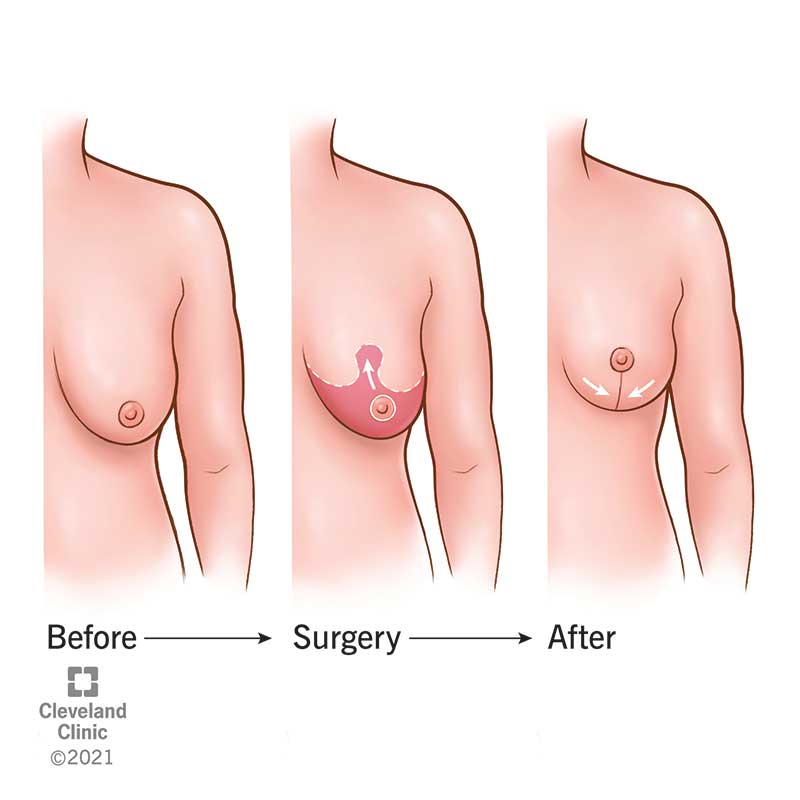Breasts may lose elasticity and sag over time because of age, pregnancy and weight changes. Breast lift, or mastopexy, is surgery to lift, reshape and tighten them. It can also improve asymmetry and other imperfections. Breast lift can be combined with breast augmentation or reduction. Results are noticeable immediately, but there are risks.
A breast lift, also called mastopexy, is surgery to change the shape and appearance of your breasts. During mastopexy, a plastic surgeon can:
Cleveland Clinic is a non-profit academic medical center. Advertising on our site helps support our mission. We do not endorse non-Cleveland Clinic products or services. Policy
As we age, our breasts change. They may lose elasticity, causing your breasts to stretch, sag or droop. Causes include:
Mastopexy can make your breasts look firmer and more youthful. A breast lift can also correct perceived imperfections, such as:
A breast lift alone won’t change the size of your breasts. But the procedure is often combined with other surgeries to make them larger or smaller. If you want to increase breast size, consider breast augmentation (implants). For smaller breasts, consider breast reduction.
Most insurance plans don’t cover the costs of cosmetic surgery. Check with your insurance plan, and ask your healthcare provider about specific costs.

Before you have mastopexy, you’ll meet with a plastic surgeon. You and the surgeon will discuss:
Your surgeon will also:
If you’re a good candidate for a breast lift and decide to move forward, your surgeon’s team will ask you to sign a consent form. By signing it, you give permission to your surgeon to perform the procedure. You also agree that you understand the risks of the procedure and have realistic expectations.
Before surgery, your plastic surgeon may ask you to:
Most breast lifts take place in a surgical center or hospital. The procedure usually lasts an hour or two, depending on how much work is being done.
The surgical team will:
Your surgeon will recommend the type of incision for you based on:
Incision types include:
Breast lift scars depend on the type of incision your surgeon used. Almost all mastopexy scars are hidden in the:
Yet you may see some scars on the surface of your breast. They’re permanent but fade a lot over time.
Most people who have mastopexy go home the same day. You should have someone drive you home and stay with you the first night.
You may have a thin tube near one or more incisions to drain fluid and prevent swelling.
Your surgical team will give you recovery instructions. They may include:
You will see the results of a breast lift immediately. Your breasts will look firmer, perkier and younger. Many people also report that their bras and clothes fit better.
A breast lift is a surgical procedure, so it comes with risks and possible complications, including:
After a breast lift, you’ll have some discomfort, swelling and bruising. Your skin may feel tight. These effects get better over time and last about two weeks.
If you had drains near the incisions, your healthcare team will remove them a few days after the procedure. Incisions may take several months to heal fully. Some surgeons prefer you to sleep on your back for a few weeks. Check with your surgeon about this.
Your surgical team will give you personalized instructions based on your surgery and recovery. Many women go back to desk work and gentle activities such as walking about a week afterward.
You may not be cleared for vigorous activities, such as lifting things, exercising and having sex, for up to six weeks.
Usually, women can wear a regular bra about eight weeks after surgery.
The results of a breast list should last for several years. But your breasts will still experience the normal effects of aging over time. Pregnancy and weight changes may affect the results of mastopexy.
Your surgical team will give you instructions on when to schedule follow-up appointments. But call your surgical team immediately if you have any of the following signs of infection:
A note from Cleveland Clinic
Our breasts tend to lose elasticity and sag over time because of gravity, age, pregnancy and weight changes. Breast lift, or mastopexy, can lift and tighten your breasts, as well as correct some perceived imperfections. However, the surgery has some risks and possible complications. Talk to a healthcare professional such as a plastic surgeon to decide if the surgery is right for you.
Last reviewed by a Cleveland Clinic medical professional on 06/19/2022.
Learn more about our editorial process.
Cleveland Clinic is a non-profit academic medical center. Advertising on our site helps support our mission. We do not endorse non-Cleveland Clinic products or services. Policy